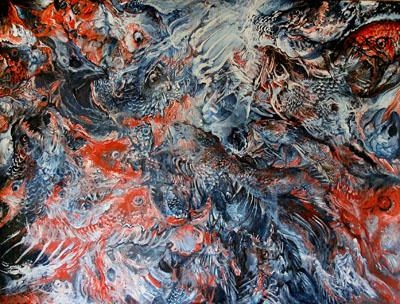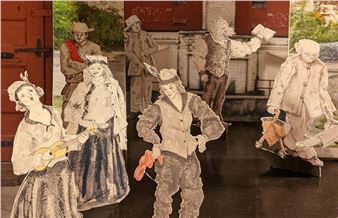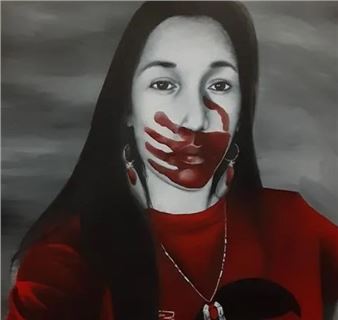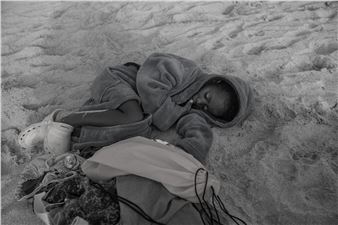The Expressive Voice: Selections from the Permanent Collection
Hyman Bloom and Jack Levine were in the first generation of the group that came to be known as Boston Expressionists. Having grown up in the Jewish immigrant communities of Boston, both artists drew on their Eastern European heritage. Levine’s work tended toward the political, Bloom’s towards an exploration of the spiritual. Working from memory rather than directly from nature, both depicted scenes inspired by the Hebrew Talmud, classical music, or the human condition.
A second generation of Boston Expressionist artists included David Aronson, Jason Berger, Francesco Carbone, Esther Geller, Kahlil Gibran, Arthur Polonsky, Henry Schwartz, Barbara Swan, Lois Tarlow, Stephen Trefonides and numerous others. Most studied at the School of the Museum of Fine Arts under the direction of Karl Zerbe, and remained committed to representational figuration at a time when the contemporary art world embraced abstraction, pop and minimalism. Photographer Jules Aarons documented the West End neighborhood where Hyman Bloom grew up and, like his contemporary Morton Bartlett, was interested in the emotional narrative of everyday life observed on the streets of Boston during the mid-twentieth century.
A third generation of Boston Expressionists were active in the 1970’s and 80’s, and continue working today. These include such diverse artists as Aaron Fink, Gerry Bergstein, Sidney Hurwitz, Jon Imber, Michael Mazur, Katherine Porter, Jane Smaldone and many others who have employed expressive, sometimes visionary approaches. Considered together, all allow viewers to trace the presence of an “expressive voice” in contemporary art. While all are unique, their work continues a tradition of painterly expressionism, expanding our consideration of painting in a digital age.

Recommended for you
Hyman Bloom and Jack Levine were in the first generation of the group that came to be known as Boston Expressionists. Having grown up in the Jewish immigrant communities of Boston, both artists drew on their Eastern European heritage. Levine’s work tended toward the political, Bloom’s towards an exploration of the spiritual. Working from memory rather than directly from nature, both depicted scenes inspired by the Hebrew Talmud, classical music, or the human condition.
A second generation of Boston Expressionist artists included David Aronson, Jason Berger, Francesco Carbone, Esther Geller, Kahlil Gibran, Arthur Polonsky, Henry Schwartz, Barbara Swan, Lois Tarlow, Stephen Trefonides and numerous others. Most studied at the School of the Museum of Fine Arts under the direction of Karl Zerbe, and remained committed to representational figuration at a time when the contemporary art world embraced abstraction, pop and minimalism. Photographer Jules Aarons documented the West End neighborhood where Hyman Bloom grew up and, like his contemporary Morton Bartlett, was interested in the emotional narrative of everyday life observed on the streets of Boston during the mid-twentieth century.
A third generation of Boston Expressionists were active in the 1970’s and 80’s, and continue working today. These include such diverse artists as Aaron Fink, Gerry Bergstein, Sidney Hurwitz, Jon Imber, Michael Mazur, Katherine Porter, Jane Smaldone and many others who have employed expressive, sometimes visionary approaches. Considered together, all allow viewers to trace the presence of an “expressive voice” in contemporary art. While all are unique, their work continues a tradition of painterly expressionism, expanding our consideration of painting in a digital age.
Artists on show
- Aaron Fink
- Arthur Polonsky
- Barbara Schwartz
- Barbara Swan
- Bernard Chaet
- Chaim Soutine
- Conger Metcalf
- David Aronson
- Erich Heckel
- Ernst Ludwig Kirchner
- Francesco Carbone
- Gerry Bergstein
- Harold Tovish
- Henry Schwartz
- Henry Thomas Schafer
- Hyman Bloom
- Jack Levine
- Jackson Pollock
- Jane Smaldone
- Jason Berger
- Jon Imber
- Jules Aarons
- Kahlil Gibran
- Karl Zerbe
- Katherine Porter
- Lawrence Kupferman
- Marianna Pineda
- Marie Cosindas
- Maxine Yalovitz-Blankenship
- Michael Mazur
- Michael Porter
- Mitchell Siporin
- Morton Bartlett
- Nan Tull
- Reed Kay
- Robert Ferrandini
- Sidney Hurwitz
- Sigmund Abeles
- Willem de Kooning
Contact details


 ARTISTS
ARTISTS














